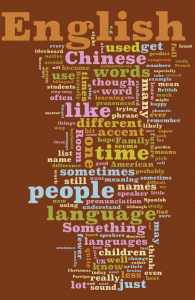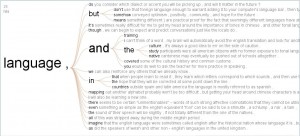Text visualisations
With the amount of information available to us these days via the internet and traditional means (books, newspapers, film, etc), it can be overwhelming to try to absorb any of it, let alone a useful amount. When people discuss terabytes, exabytes, and zettabytes worth of data, your average person will have no means to comprehend the enormity of the available information. According to Mark Wattenberg, in an interview he did with Wired magazine, the total number of words a human will hear in a lifetime will be less than a terabyte of data.
Wattenberg and a colleague at IBM have created Many Eyes, a website that enables visualisations of data sets, large and small. If you’ve ever wanted to see an analysis of Mr Potato Head on Wikipedia, or how many educators are on Twitter, this is the place to go.
An increasingly-popular way to quickly analyse text is by using word clouds (or tag clouds). Common words are shown in a larger font, and rarer words in a smaller font. It’s a quick way to see which words or tags are reoccurring or barely used in a block of text or on a website. Bloggers are using them to quickly display the most common topics covered in their posts.
I think it would be interesting to see how they can be used in learning, perhaps to track progress of learned words, or patterns in writing. Or look at foreign language media to see which common words would be the most useful to learn. Granted, I may just be being creative with suggestions because I really like graphics, but I think they’re worth playing around with.
Another interesting thing that Many Eyes have made easily available is the word tree. You can select a word and then see the relationships it has with words or punctuation following it. Following the pathways can be quite interesting.
Below are a couple of examples that I’ve done using the text from this blog. Wordle makes it really easy to make word trees, using either text or a URL that contains an Atom or RSS feed (perfect for making clouds from blogs). Click on the word cloud for a bigger view, and click on the word tree to visit the interactive version so you can play around with it yourself.


